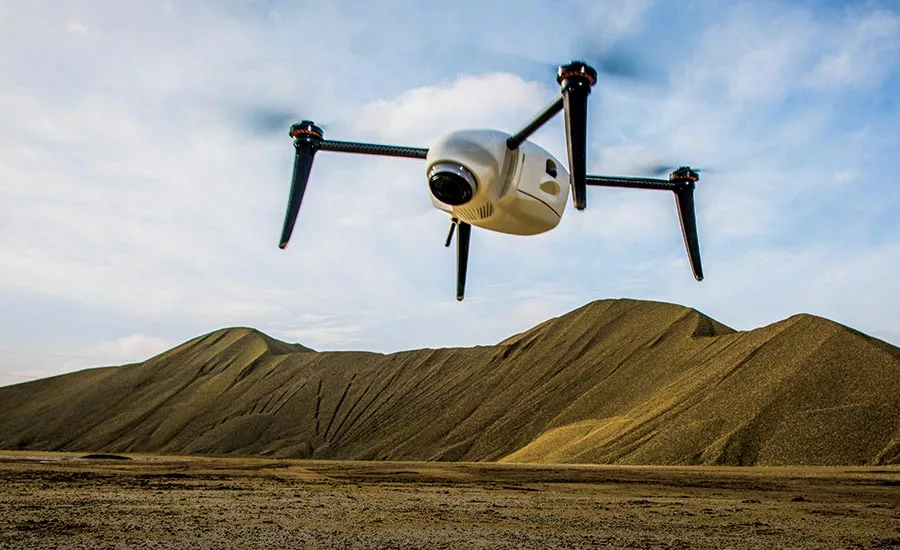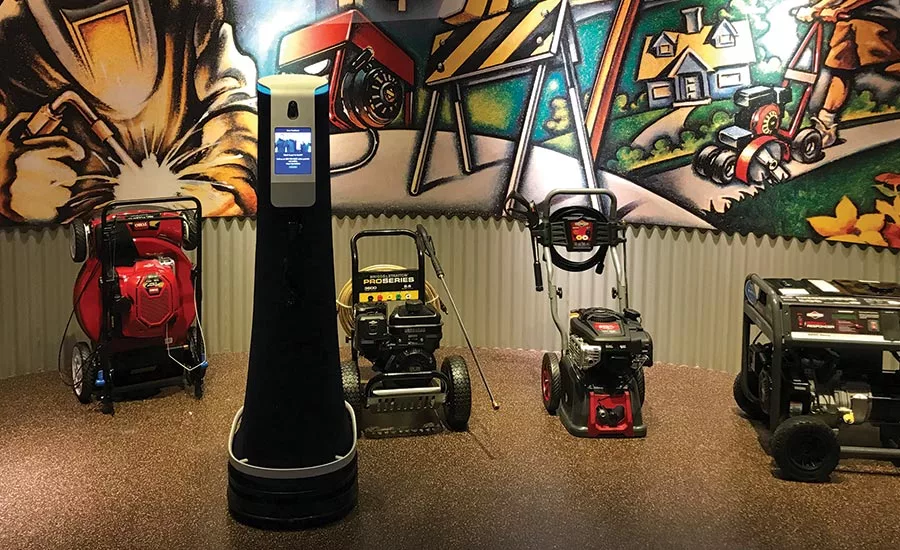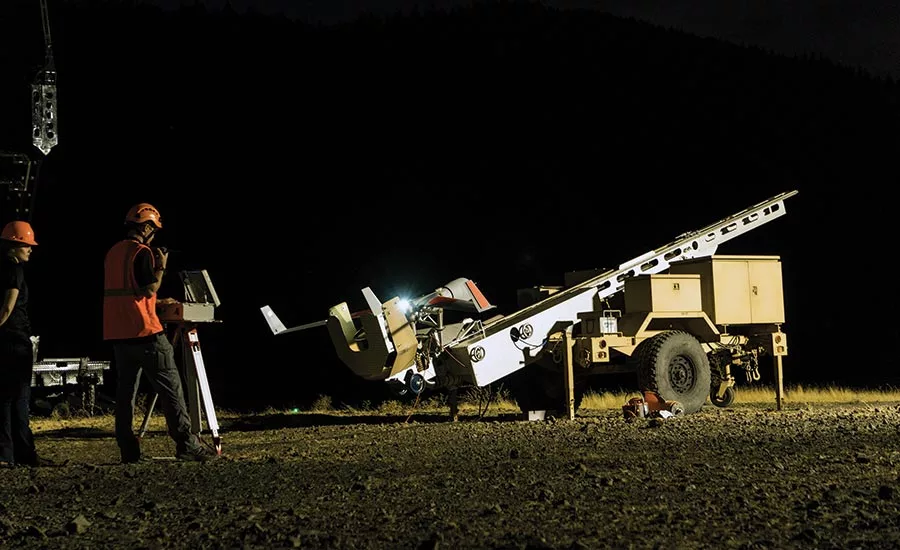Robots and Drones -- the Future of Enterprise Security?
Enterprise security is increasingly embracing the use of drones, robots and other automated technology to mitigate risks, manage costs and boost productivity


A Cobalt Robotics security robot is not only patrolling Briggs & Stratton manufacturing plants and warehouses, but is adding value to other areas of the enterprise. “We have deployed it to patrol cubicle office settings, conduct off hours patrols, and have also begun to use them more actively in day shift and higher traffic times at entrances in and out of our buildings, to monitor access control and to challenge non-badged individuals to identify policy violations. We expect to rapidly deploy them into other areas where we need coverage,” says Dave Droster, director of global security.
Photo courtesy of Cobalt Robotics

Flying at night, when manned aircraft typically are grounded due to safety concerns, the Insitu team flew the ScanEagle UAS beyond visual line of sight at last year’s Paradise camp fire in Northern California, providing perimeter mapping, hot spot locations and points of interest, while disseminating real-time video feed to assist CALFIRE along with multiple local and national firefighting response teams in their daily morning planning meetings. The up-to-date information provided fire incident commanders with enhanced emergency response efforts, increased situational awareness and safety and supported planning and resource allocation.
Photo courtesy of Insitu

“Buddy”, a security robot from Knightscope, watches the entrances to the Pechanga Resort and Casino in Temecula, Calif.
Photo courtesy of Pechanga Resort and Casino
Several times a week, Joe Norman, scale house manager for the Dunham Price Group, has to count the amount of tonnage that’s in a pile of rocks.
Norman is the Scale House Supervisor at Dunham Price, a concrete and aggregates company in Louisiana and Texas. He’s responsible for measuring and reporting inventory of rock piles that will eventually become concrete. In the past, that meant trying to physically measure piles that are 50 feet tall and have 50,000 tons of rock in them.
The rock piles can’t be climbed upon: they will shift and cascade down and possibly collapse upon anything that’s in the way, including humans and large machinery.
“The rock piles are never uniform or square, and counting the tonnage by hand can force you to be inaccurate by thousands of tons and thousands of dollars,” Norman says. In addition to inaccuracies created by not being able to see or stand on an entire rock pile, Norman had to navigate dozens of vehicles roaming the property and loading or unloading rock, from pickup trucks to 18 wheelers. And then there are snakes and the Louisiana heat.
Norman recently employed a drone from Kespry, based in Menlo Park, Calif., to count the tonnage (up to three percent accuracy). He’s seen immediate money savings, in addition to a safer work environment.
There are also efficiencies in how quickly the work is now done. “We tried using a third party, but that became too expensive,” Norman says. “I was also traveling to several sites to take the measurements, and that was time consuming and costly, as well.”
Kespry has an aerial intelligence platform based on the use of industrial drones powered by artificial intelligence and machine learning. Kespry’s aerial intelligence platform is used in cases such as construction, mining and aggregates, as well as insurance claims. What makes Kespry’s drones more durable than “off-the-shelf” rivals, says the company, is that they can withstand higher-wind conditions and handle longer flight times, which is perfect for the work that Norman does each day.
The Kespry drone is larger by drone standards, as it contains a four-propeller machine, but it’s easy for Norman to use, he says. Norman programs it, it flies over the rock piles and within a short period of time, Norman has topographic photos that allow him to count the tonnages. “The drone has saved us money and reduced human error.”
Here Come the Drones
There were more than 170 exhibitors in the drone category at this year’s Consumer Electronics Show in Las Vegas. They came in all forms, including a bunch that were all wet, such as the Robosear Robo-shark that swims underwater with a caudal fin.
The show is a great opportunity to view the future of drones for multiple uses, but what about for security and safety? What are the remaining challenges that limit the potential of drones and UAVs for enterprise security? How much depends on security industry interest, and how much depends on regulatory or legislative action? And are public perceptions of drones still negative?
“Drone tourism definitely placed a stigma on the drone industry,” says Paul Allen, Key Account Manager, Emergency Services for drone company Insitu. “The tourism part of it has included instances where the drones have been intrusive, or flown over stadiums or airports. People have been hurt. And it doesn’t help that the FAA hasn’t been clear with their regulations. So the negative aspects of it have been hard to overcome.”
“The FAA Reauthorization Act is one attempt to fix the problem,” Allen adds, “but we still need full integration into the National Airspace System.”
The good work that Insitu drones and UAVs are doing, however, may help to change that stigma. For example, Insitu drones were used throughout the 2017/2018 fire seasons in Oregon and California helping with wildfire suppression using the company’s ScanEagle Unmanned Aerial System (UAS) and its payloads, which include IR and EO cameras and sensors. Also, in 2017, the company’s technology assisted with disaster recovery during the aftermath of Hurricane Harvey.
The Insitu UAVs can be flown at night and over dense smoke (when typical manned aircraft are grounded due to safety reasons). Full-motion video and geospatial mapping from the overnight hours of an active fire can be sent real time to fire incident management teams that can be used for intelligence in their early morning planning meetings, and much more. Drones can be equipped with infrared cameras that peer through smoke, as well as sensors for wind direction and other weather variables that affect how wildfires spread. They can fly through canyons and other cramped spaces where helicopters can’t fly and glide low enough to capture high-resolution footage.
During Hurricane Harvey, Insitu drones helped with recovery efforts. The drones flew over the Port of Corpus Christi to identify debris and other materials that were clogging the waterways and the shipping lanes. “We don’t need a runway so we can launch and recover with a retrieving system,” Allen says. “We provided high-accuracy imagery to tell the port where the issues were on the waterways and help them open that port back up, which was crucial, as $100 million a day operates through that port.”
David Small, Safety, Security & Fire Protection, North America Manufacturing Operations for Ford Motor Company, is one security executive who is just beginning his journey into drone use, but already expecting good things to come. Working with Eric Gilbo from Allied Universal, Small is getting set to implement Asylon’s Autonomous DroneCore System.
“What has been driving my interest is not just the technology aspect [of the drone], but the potential for our team to become more efficient as well,” Small says. “After our vehicles are assembled and tested, they are moved to a finished vehicle lot for shipment. We’ve had some thefts in the past, and although that responsibility may reside with the transport company, we still have an image to maintain and an obligation to our end customers to ensure their vehicle is received. That’s where use of the drone is going to help us, by providing extra coverage of storage lots. We also are going to pilot the use of drones in our parking lots at our manufacturing facilities. Some of them have 1,500 or more employees – they are like a small city with parking lots. And we want to protect our employees and their vehicles. So overall, the drone is going to help us to improve our processes, be more efficient, get more eyes on the ground and deter thefts.”
The data from the drones will be transmitted real time to Ford Security, so if a theft or crime does occur, Allied Universal security officers can respond. “We can get more coverage without increasing staffing levels while also focusing more attention on known problem areas,” Small says.
Michael Quiroga, Chief Revenue Officer at Asylon, agrees with Allen regarding the barriers that still exist when it comes to drone deployment. Yet, he stresses the benefits, particular the all-encompassing service that enterprise security can receive. Regarding the Ford application, he says, “The business model is a Drone-As-A-Service but in reality, it’s a white glove service. We handle the insurance, in addition to the FAA waivers. We also provide training and ensure those who use the drone are certified by the FAA to operate it. The training is not only designed to teach someone how to utilize the system, but also for safety. Our system, by default, has a parachute, nighttime locating beacons and geo-fence capabilities.”
A Repeat Customer
Similar to drones, security robots have been challenged with misunderstandings about their capabilities and their use. Security robots can offer end users and enterprise security leaders the ability to improve operational efficiencies, safely and securely patrol large areas and integrate seamlessly with existing security technologies.
When it comes to security robots, Dave Droster is a fan. Droster, director of global security for Briggs & Stratton in Milwaukee, Wis. has employed a security robot since 2016 to patrol and monitor the company’s warehouse. After a major management change with the robotics company, Droster began working with Cobalt Robotics in San Mateo, Calif.
“I found Cobalt and I realized that the founder was an incredibly gifted scientist who was developing a security robot with a human in the loop. I told him that we’d like to be his real world lab. So we essentially picked up where we left off, but it’s a better situation.”
The Cobalt security robot is not only patrolling Briggs & Stratton manufacturing plants and warehouses, but is adding value to other areas of the enterprise. “We have deployed it to patrol cubicle office settings, conduct off hours patrols, and have also begun to use them more actively in day shift and higher traffic times at entrances in and out of our buildings, to monitor access control and to challenge non-badged individuals to identify policy violations. We expect to rapidly deploy them into other areas where we need coverage. Doing so will eliminate me needing to add extra guard force at short notice and paying a double-time rate.”
When asked why many enterprise security executives haven't yet embraced security robots, Droster says, “Too many buzzwords are thrown around,” Droster says. “We talk about AI, machine learning and predictive analytics, but overall, robots are a misunderstood concept. From a security professional perspective, it may be too much of bleeding-edge technology – it’s still not on everyone’s radar. Also, not a lot of integrators or guard companies are talking about it. In reality, a guard force provider could change their entire revenue stream and their business model to benefit them. A guard force provider should examine how long it takes to find people and train them, when a robot could be deployed in that same position. Then, you give your guard force even greater responsibilities that require advanced skillsets.”
Droster says he won’t replace his guard force with the Cobalt robots. He wants them both a part of the Briggs & Stratton enterprise security team. “Every day we meet with our guard force account manager to discuss the previous day’s events, and we see our guard force coming up with some great future use cases for the robot. Some examples include the robot ensuring that the warehouse aisles are clear, possibly asking the robots to check fire extinguishers expiration dates while on tour….things like that. But overall, I had found that I can deploy robots using a cost-effective model that will free up more up my operating budget to pay for highly skilled managers to act upon the data that the security robots are providing. And all done in a very predictive way. I think that’s the model of the future.”
For certain, “our security robots are not meant to replace our guard force,” adds Robert Krauss, Vice President of Public Safety for Pechanga Resort and Casino in Temecula, Calif. The casino is the largest casino on the West coast and one of the largest in the country, with 200,000 square feet of gaming space. Pechanga recently completed a 27-month, $300 million expansion that nearly doubled its room capacity to 1,090, expanded its spa facility to 25,000 square feet, created a 40,000-square foot events center and built a 4 ½-acre tropical pool complex.
The casino’s public safety team includes 300 officers – “like a small police department,” Krauss says. Krauss has a detective division, a team that works with local law enforcement and the Riverside County Sheriff’s department, and an inside and outside patrol division with armed and unarmed officers.
“I have been researching Knightscope robots for some time,” Krauss says. “Everyone says to ‘think out of the box,’ but I threw away the box a long time ago. You have to, in this day and age. I picked Knightscope, in part, because of their location on the west coast.”
Krauss has “Buddy,” a K5 mobile unit on patrol in the atrium and hotel lobby, and “Rudy,” a kiosk-type K1 unit in the casino’s valet entrance. “When I first started to use them, my initial theory was to put Buddy outside to patrol but I also wanted to see how people would react to him, that they were comfortable. Buddy is now part of that area – people expect to see him – and his presence gives us a different perspective on that area. People take selfies with him and we provide a feeling to guests that we are going out of our way for their safety.”
Krauss plans to add four more security robots at the resort’s entrances, in addition to a drone to patrol the golf course. “Overall, the robots show the dedication that Pechanga has to the safety and security of its patrons and team members,” he says.
Looking for a reprint of this article?
From high-res PDFs to custom plaques, order your copy today!





